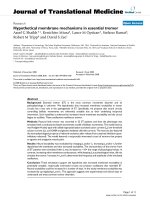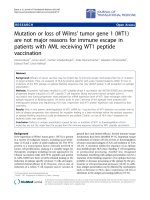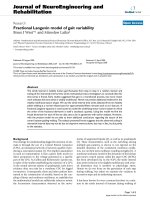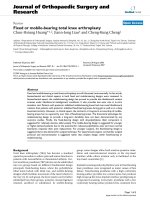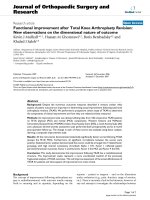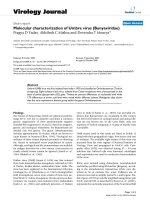báo cáo hóa học:" Fixed or mobile-bearing total knee arthroplasty" pdf
Bạn đang xem bản rút gọn của tài liệu. Xem và tải ngay bản đầy đủ của tài liệu tại đây (882.25 KB, 8 trang )
BioMed Central
Page 1 of 8
(page number not for citation purposes)
Journal of Orthopaedic Surgery and
Research
Open Access
Review
Fixed or mobile-bearing total knee arthroplasty
Chun-Hsiung Huang*
1,2
, Jiann-Jong Liau
3
and Cheng-Kung Cheng
2
Address:
1
Department of Orthopaedic Surgery, Mackay Memorial Hospital, No. 92, Sec. 2, Chung-San North Road, Taipei 104, Taiwan,
2
Institute
of Biomedical Engineering, National Yang Ming University, No. 155, Sec 2, Li-Nung Street, Taipei 112, Taiwan and
3
School and Graduate Institute
of Physical Therapy, College of Medicine, National Taiwan University, 3F, No. 17, Xuzhou Road, Taipei 100, Taiwan
Email: Chun-Hsiung Huang* - ; Jiann-Jong Liau - ; Cheng-Kung Cheng -
* Corresponding author
Abstract
Fixed and mobile-bearing in total knee arthroplasty are still discussed controversially. In this article,
biomechanical and clinical aspects in both fixed and mobile-bearing designs were reviewed. In
biomechanical aspect, the mobile-bearing design has proved to provide less tibiofemoral contact
stresses under tibiofemoral malalignment conditions. It also provides less wear rate in in-vitro
simulator test. Patients with posterior stabilized mobile-bearing knees had more axial tibiofemoral
rotation than patients with posterior stabilized fixed-bearing knees during gait as well as in a deep
knee-bend activity. However, in clinical aspect, the mid-term or long-term survivorship of mobile-
bearing knees has no superiority over that of fixed-bearing knees. The theoretical advantages for
mobile-bearing design to provide a long-term durability have not been demonstrated by any
outcome studies. Finally, the fixed-bearing design with all-polyethylene tibial component is
suggested for relatively inactive, elder people. The mobile-bearing design is suggested for younger
or higher-demand patients due to the potential for reduced polyethylene wear and more normal
kinematics response after joint replacement. For younger surgeon, the fixed-bearing design is
suggested due to less demand for surgical technique. For experienced surgeon, one familiar surgical
protocol and instrumentation is suggested rather than implant design, either fixed-bearing or
mobile-bearing.
Background
Total knee arthroplasty (TKA) has become a standard
operative procedure to relieve pain and restore function in
patients with osteoarthritis or rheumatoid arthritis. Cur-
rent total knee prosthesis (TKP) devices can be subdivided
into two groups based on different fundamental design
principals: fixed-bearing knees, where the polyethylene
tibial insert locked with tibial tray, and mobile-bearing
designs which facilitate movement of the insert relative to
the tray [1]. In each group, the knee system can be further
subdivided into three groups, posterior cruciate ligament
retained, sacrificed or substituted. In mobile-bearing
group, some designs allow both anterior-posterior trans-
lation and internal-external rotation at the tray-insert
interface while others rotation only is facilitated at the
tray-insert counterface [1].
Implant loosening and polyethylene wear in fixed-bearing
knee prostheses were recognized as major causes of late
failure. Fixed-bearing prosthesis with a high conformity
bearing surface provides low contact stress, but produces
high torque at
the bone-implant interface predisposing to
component loosening. Conversely, prosthesis with a low
conformity bearing surface produces less constraint force
Published: 05 January 2007
Journal of Orthopaedic Surgery and Research 2007, 2:1 doi:10.1186/1749-799X-2-1
Received: 28 August 2006
Accepted: 05 January 2007
This article is available from: />© 2007 Huang et al; licensee BioMed Central Ltd.
This is an Open Access article distributed under the terms of the Creative Commons Attribution License ( />),
which permits unrestricted use, distribution, and reproduction in any medium, provided the original work is properly cited.
Journal of Orthopaedic Surgery and Research 2007, 2:1 />Page 2 of 8
(page number not for citation purposes)
that decreasing component loosening, but generates high
contact stress leading to early failure of the polyethylene
[2,3]. Furthermore, the kinematic conflict between low-
stress articulations and free rotation cannot be solved by
any fixed-bearing knee design [4].
Mobile-bearing knee prosthesis was introduced with the
aim to reduce polyethylene wear and component loosen-
ing [5]. The mobile-bearing design provides both congru-
ity and mobility in the tibiofemoral bearing surface. This
allows low contact stress and low constraint force to
improve wear resistance and, theoretically, to minimize
loosening [4]. In addition, the mobile-bearing knee also
solves the kinematic conflict of fixed-bearing knee
because a high conforming articular surface can now coex-
ist with free rotation [4].
Although mobile-bearing design has hypothetical advan-
tages over fixed-bearing knee, both designs show excellent
survival rates of up to 95% in 10-year follow-up [6-11]
and comparative studies could not demonstrate the supe-
riority of one or the other design [10,12-14]. It appears we
are at a crossroad. In this article, two aspects including
biomechanical and clinical analysis in both fixed and
mobile-bearing designs were reviewed.
Biomechanical review
Tibiofemoral contact stress under malalignment
conditions
Many biomechanical studies have demonstrated that con-
tact stress on the tibial polyethylene component is closely
related to polyethylene wear [2,15]. Matsuda et al [16]
measured the contact pressures on the upper- and under-
surface of the tibial polyethylene insert with a neutral and
malrotated tibial tray of three mobile-bearing designs and
one fixed-bearing design. They found mobile-bearing
design appears to offer advantages over the fixed-bearing
design when moderate rotational malalignment of the
tibial component occurs. Stukenborg-Colsman et al [17]
used an electronic resistive pressure sensor to measure
tibiofemoral contact stresses of fixed and mobile-bearing
TKP under dynamic loading conditions. Stresses were
measured at the tibial component aligned normally, as
well as in internally and externally rotated positions. Their
result showed that increase of contact stresses in a malro-
tated tibial component were seen with the standard con-
formity fixed-bearing design while these increases were
not observed with the high-conformity fixed-bearing and
mobile-bearing designs. They also suggested that mobile-
bearing design allowing tibial insert to translate on the
tibial baseplate permits the component to align itself with
the femoral component so that contact area is maximized
and contact stress is reduced. This feature of mobile-bear-
ing design reduces the likelihood of cold flow and stress-
peak damage. In addition, we also investigated the contact
stresses in tibial polyethylene component of fixed and
mobile-bearing knee prostheses under medial-lateral,
anterior-posterior maltranslations and in internal-exter-
nal malrotations of tibiofemoral joint [18]. Our result
showed that the mobile-bearing design can reduce maxi-
mum contact pressure more significantly than the fixed-
bearing design when malalignment conditions of the tibi-
ofemoral joint occurs, especially in the internal/external
malrotation (Fig 1). The mobile-bearing design offers the
advantage of self-adjustment over the fixed-bearing
design to accommodate surgical malalignment. Based on
above-mentioned biomechanical studies, the advantage
of mobile-bearing design to decrease contact pressure on
the tibial articular surface under malalignment conditions
of tibiofemoral joint has been proved.
Wear rate and wear particles in fixed and mobile-bearing
designs
One major goal of mobile-bearing knee is to reduce the
overall wear damage by increasing the contact area, while
minimizing the constraint and encouraging nature knee
motion, by allowing the polyethylene bearings to move
freely on polished plates on the upper tibia [19]. McEwen
et al. [1] used a physiological knee simulator to compare
the wear rate of fixed-bearing and rotating platform
mobile-bearing TKP. The PFC Sigma rotating platform
mobile-bearing knee (Depuy, Warsaw, IN) exhibited a
mean wear rate of 5.2 ± 3.8 mm
3
/million cycles when sub-
jected to standard kinematics with force-controlled ante-
rior-posterior translation. This showed a two-fold
reduction in volumetric wear rate in comparison to the
fixed-bearing PFC Sigma knees subjected to intermediate
kinematics (9.8 ± 3.7 mm
3
/million cycles). The authors
[1] attributed the lower wear rate in mobile-bearing
design to that rotating platform mobile-bearing design
redistributes the motions between the femoral-insert and
tray-insert articular surfaces. Most of the rotation occurs at
the tray-insert articular surface, which is simply a unidirec-
tional rotation motion and is known to produce low wear
[20,21]. In contrast, rotation of the PFC Sigma fixed-bear-
ing knee occurs entirely at the femoral-insert articulation.
The resulting multidirectional wear path at the interface
increases the amount of cross shear on the polyethylene
articulating surface, therefore, produces a greater polyeth-
ylene wear rate [1]. However, lower wear rate cannot rep-
resent lower risk of osteolysis in vivo because the tissue
response is depended on the size distributions of wear
particles. When the particle size from different types of
knee prosthesis were measured, the less conforming the
design, the higher the surface damage, but the larger the
particle size [22]. Mobile-bearing knee may have a higher
rate of production of smaller particles than fixed-bearing
knee due to its larger contact area. This hypothesis was dis-
proved by an in vitro pin-on-disk wear test [19]. In that
study, the authors showed that the wear rates of knee
Journal of Orthopaedic Surgery and Research 2007, 2:1 />Page 3 of 8
(page number not for citation purposes)
(A) Maximum contact pressures in the anterior (A) and posterior (P) maltranlations (mm) of femoral component relative to the neutral contact alignment at 0° of flexion; (B) Maximum contact pressures in the medial (M) and lateral (L) maltranlations (mm) of femoral component relative to the neutral contact alignment at 0° of flexion; (C) Maximum contact pressures in the internal malrotation (IR) and external malrotation (ER) (degrees) of femoral component relative to the neutral contact align-ment at 0° of flexionFigure 1
(A) Maximum contact pressures in the anterior (A) and posterior (P) maltranlations (mm) of femoral component relative to
the neutral contact alignment at 0° of flexion; (B) Maximum contact pressures in the medial (M) and lateral (L) maltranlations
(mm) of femoral component relative to the neutral contact alignment at 0° of flexion; (C) Maximum contact pressures in the
internal malrotation (IR) and external malrotation (ER) (degrees) of femoral component relative to the neutral contact align-
ment at 0° of flexion. (*) indicates there is statistically difference between fixed-bearing and mobile-bearing design.
0
5
10
15
20
25
A 4 mm A 2 mm Neutral P 2 mm P 4 mm
Maximum Contact Pressure(MPa)
Fixed bearing Mobile bearing
(A)
0
5
10
15
20
25
30
M 1 mm M 0.5 mm Neutral L 0.5 mm L 1 mm
Maximum Contact Pressure (MPa)
Fixed bearing Mobile bearing
(B)
0
5
10
15
20
25
30
IR 10 IR 5 IR 3 IR 1 Neutral ER 1 ER 3 ER 5 ER 10
Maximum Contact Pressure (MPa)
Fixed bearing Mobile bearing
(C)
*
*
*
*
*
*
*
*
*
*
*
Journal of Orthopaedic Surgery and Research 2007, 2:1 />Page 4 of 8
(page number not for citation purposes)
prosthesis with large contact areas, such as mobile-bear-
ing designs, can be much less than that of fixed-bearing
designs. However, there is no disadvantage regarding par-
ticle type or size associated with the larger contact areas.
In vitro kinematics of fixed and mobile-bearing knees
In vitro cadaveric kinematics study under controlled labo-
ratory condition was conducted by Most et al [23]. In their
study, eleven human knee specimens retrieved post-mor-
tem were tested using a robotic system. The tibiofemoral
translation and rotation of the intact and two recon-
structed knees, fixed-bearing posterior stabilizing knee
(LPS-Flex, Zimmer, IN) and mobile-bearing posterior sta-
bilized knee (LPS-Mobile, Zimmer, IN), were compared.
One force-moment control algorithm [24] to determine
the passive path from full extension to 120° and three var-
iations of muscle loads were simulated in that study: (1)
isolated quadriceps force of 400 N; (2) combined quadri-
ceps (400 N) and hamstrings (200 N) load; and (3) iso-
lated hamstring force of 200 N. The kinematics of the
intact and reconstructed knees under these simulated
muscles loads was measured at selected flexion angles
(0°, 30°, 60°, 90° and 120°). Their results indicated that
for all knees posterior femoral translation occurs along
the passive path and under muscle loading conditions.
Furthermore, increasing flexion angle corresponded with
increased internal tibial rotation. Femoral translation and
tibial rotation for fixed- and mobile-bearing posterior sta-
bilized knees were similar despite component design var-
iations. However, both reconstructed knees only partially
restored intact knee translation and rotation.
In vivo kinematics of fixed and mobile-bearing knees
In vivo kinematics studies by using fluoroscopy have been
conducted on subjects with normal knee joints and on
patients who had implantation of a fixed-bearing or
mobile-bearing TKP [25-30]. The most important param-
eters, the anterior-posterior translation and axial tibi-
ofemoral rotation, have been determined in some studies
of Low Contact Stress (LCS) posterior-cruciate-sacrificing
rotating platform and posterior stabilized rotating plat-
form mobile-bearing knees (Depuy, Warsaw, IN) [25,26].
In normal knee's kinematics as the subject performed a
weight-bearing deep knee-bend, there is posterior transla-
tion (14.2 mm) of lateral femoral condyle with progres-
sive knee flexion [31]. Contact pathways in patients who
had a posterior-cruciate-retaining fixed-bearing knee
showed a small amount of posterior femoral rollback (4.8
mm) in the lateral component occurred during the first 60
degrees of flexion, following by anterior femoral transla-
tion as the knee flexed from 60 to 90 degrees [25]. Patients
with a rotating platform knees had minimal anteroposte-
rior tibiofemoral translation during a deep knee-bend,
with tibiofemoral contact point remaining near the mid-
dle of the articular surface of tibial component [4].
Patients who had a posterior stabilized fixed-bearing TKA
routinely demonstrated posterior femoral rollback in the
lateral component during knee flexion, although it was
less in magnitude than that in the normal knees [31].
However, patients who had a posterior-cruciate-retaining
fixed bearing knee experienced a paradoxical anterior
femoral translation during a deep knee-bend [32]. On the
other hand, patients managed with a posterior-cruciate-
sacrificing rotating platform knee replacement had poste-
rior femoral rollback of the lateral femoral condyle from
full extension to 90 degrees of flexion, but they actually
experienced anterior translation from 60 to 90 degrees of
flexion [4]. Patient who had a posterior stabilized rotating
platform knee replacement showed more substantial pos-
terior femoral rollback of the lateral condyle during the
deep knee-bend [4].
Axial tibiofemoral rotation after TKA is another important
parameter for knee's kinematics. A multicenter analysis to
determine in vivo axial tibiofemoral rotational magnitude
and patterns in 1,027 knees was reported [33]. In that
study, normal knees showed 16.5° and 5.7° of internal
tibial rotation during a deep knee-bend and gait, respec-
tively. Patients with a posterior stabilized mobile-bearing
knee prosthesis had, on average, more rotation (2.2°)
than patients with a posterior stabilized fixed-bearing
knee (1.4°) during the stance-phase of gait. However,
patients with posterior-cruciate-retaining fixed-bearing
(2.1°) knee had less rotation than patients with a poste-
rior-cruciate-retaining mobile-bearing knee (0.1°). In a
deep knee-bend activity, patients with posterior stabilized
mobile-bearing design had a mean rotation of 3.9° while
patients with posterior stabilized fixed-bearing one had
3.1° of rotation. Patients with posterior-cruciate-retaining
mobile-bearing knee had a mean rotation of 3.9° while
patients with posterior-cruciate-retaining fixed-bearing
one had 3.7° of rotation. In addition, Ranawat et al [29]
also investigated the tibiofemoral rotation in mobile-
bearing PCL-sacrificed knee and fixed-bearing posterior
stabilized knee during deep knee-bend activity. Although
their results indicated that patients with a mobile-bearing
prosthesis (7.3°) experienced a statistically greater
amount of axial rotation than patients with a fixed-bear-
ing prosthesis (4.1°), it is difficult to say the mobile-bear-
ing knee has a greater axial rotation than fixed-bearing
knee in vivo due to different design concept for implants,
ie, PCL sacrificed vs posterior stabilized. Based on above-
mentioned studies, patients with any design of knee pros-
theses (fixed-bearing or mobile-bearing) had smaller fem-
oral rollback as well axial rotation than normal knees
during gait and a deep knee bend. In addition, high vari-
ability in femoral rollback and axial rotation patterns and
magnitudes were seen among different TKA designs.
Journal of Orthopaedic Surgery and Research 2007, 2:1 />Page 5 of 8
(page number not for citation purposes)
Clinical review
Osteolysis and wear particle in failed fixed-bearing and
mobile-bearing knee arthroplasties
Osteolysis has been well documented as a major compli-
cation after TKA [34-37]. The advantages of the mobile-
bearing TKA are to minimise component loosening and
minimise polyethylene wear. At a minimum of 15 years
follow-up for cemented rotating-platform mobile-bearing
TKA, Callaghan et al [38] reported no knee was revised
because of loosening, osteolysis, or wear in their series of
37 patients (53 knees). However, osteolysis and polyeth-
ylene wear in rotating-platform mobile-bearing TKA was
found in author's series. In our previous study [39], eighty
revision TKAs with radiographic evidence of advance pol-
yethylene wear were reviewed. The mobile-bearing group
consisted of thirty-four knees (21 meniscal bearing and 13
rotating platform) with a LCS implant and the fixed-bear-
ing group included forty-six knees. The prevalence of oste-
olysis was significantly higher in the mobile-bearing
group (47%, 8/21 for meniscal bearing and 8/13 for rotat-
ing platform) than in the fixed-bearing group (13%). The
osteolysis was predominantly on the femoral side, adja-
cent to the posterior aspect of the condyle. One possible
reason inducing higher osteolysis rate in mobile-bearing
knees was smaller phagocytosable polyethylene particles
might be generated owing to the more conformed articu-
lar surface and additional undersurface wear. Although
this hypothesis was disproved by an in vitro wear test [19],
our another study to compare the particle size and mor-
phology of polyethylene wear debris between failed
mobile-bearing and fixed-bearing knees has proved this
hypothesis [40]. In that study, tissue specimens from
interfacial and lytic regions were excised during revision
surgery. Ten mobile bearing knees (all of the LCS design)
and 17 fixed bearing knees (10 of the porous-coated ana-
tomic (PCA) (Howmedica, Rutherford, NJ) and 7 of the
Miller/Galante design (Zimmer, Warsaw, IN) were
included in this study. Polyethylene particles were iso-
lated from the tissue specimens and examined using both
scanning electron microscopy (Hitachi S-3500 N, Tokyo,
Japan) and light-scattering analyses (Master-sizer 2000,
Malvern, PA). The LCS mobile bearing knees produced
smaller particulate debris (mean equivalent spherical
diameter: 0.58 µm in LCS, 1.17 µm in PCA and 5.23 µm
in M/G) and more granular debris (mean value: 93% in
LCS, 77% in PCA and 15% in M/G) (Fig 2). Therefore the
mobile-bearing knee may be at increased risk for osteoly-
sis.
Potential risks associated with mobile-bearing knees
Despite many studies demonstrated advantages of using a
mobile-bearing knee [4,9,38], especially for rotating plat-
form design, several concerns have been expressed includ-
ing the need for a more exacting surgical technique and
the occurrence of bearing dislocation [41]. In the previous
SEM microphotographs of ultra-high molecular weight poly-ethylene wear debris of M/G knee (A), PCA knee (B) and LCS knee (C)Figure 2
SEM microphotographs of ultra-high molecular weight poly-
ethylene wear debris of M/G knee (A), PCA knee (B) and
LCS knee (C). Note: G: granule, B: bead, F: fibril and S: larger
shred.
(A)
(B)
(C)
Journal of Orthopaedic Surgery and Research 2007, 2:1 />Page 6 of 8
(page number not for citation purposes)
reported series [42-44], the dislocation rate in LCS knee
systems occurs is less than 3.5% of cases, although Bert et
al. [45] reported a higher incidence of 9.3%. All of these
events occurred in early stage after knee arthroplasty and
were attributed to improper surgical technique. Technical
pitfalls predisposing to this complication including mal-
rotation of tibial baseplate and failure to produce prop-
erly balanced flexion and extension tension between the
femoral and tibial bearing interfaces [46]. In addition we
also reported five cases with late rotational dislocation of
the rotating platform bearing in the LCS knee system [41].
The prostheses had functioning well for 8 to 12 years
before failure. Pre-operative radiographs showed asym-
metric tibiofemoral joint spaces. Entrapment of dislo-
cated bearing in three patients (Fig 3) and spontaneous
reduction of the dislocated bearing in another two
patients were seen at revision. Tibiofemoral ligamentous
laxity was found after reduction. The retrieved polyethyl-
ene bearings showed advanced wear and cold flow
deformities and thickness was reduced. The rotational
degree of the LCS rotating platform bearing is unre-
stricted, which may result in late dislocation. To prevent
late dislocations, a restraint mechanism is suggested to
limit rotation within 30 degrees of the polyethylene ele-
ment on the tibial baseplate.
Long-term results of fixed-bearing and mobile-bearing
knee arthroplasties
Some conventional fixed-bearing TKAs have been proved
to be clinical successful. Survivorship of the Genesis
(Smith and Nephew, Memphis, TN) TKA was 96% at 10
years follow-up [47]. Ritter et al [48] reported a survivor-
ship of 98.8% at 15 years with the Anatomic Graduated
Components (Biomet, Warsaw, IN) TKA. The survival rate
of the Total Condyle knee prostheses (Howmedica,
Rutherford, JN) was 95% at 15 years, 98% at 20 years and
91% at 23 years in different studies [49-51]. In our expe-
rience [52], using revision for mechanical failure as an end
point, the 20-year overall survival rate with the Total Con-
dyle knee prostheses was 91.9%. We also found the sur-
vival rate for the all-polyethylene tibial component was
96.4% and for the metal-backed tibial component was
88.4%. The use of more-cost effective and durable all-pol-
yethylene tibial component for a primary cemented TKA,
particularly in Asians with a relatively low weight and
inactive, especially in elderly people is suggested.
However, in the current situation, surgeons face more and
more young, active patients who need TKA. Patient's
expectations for a more functional and longer-lasting
result following TKAs continue to drive advances in both
implant design as well as the surgical technique. The
mobile-bearing knee prosthesis was designed to reduce
contact stress and constraint force, which potentially, pro-
vided long-term durability. Buechel et al [8] reported a 20-
(A) An anteroposterior radiograph revealed complete absence of the femorotibial joint spaceFigure 3
(A) An anteroposterior radiograph revealed complete
absence of the femorotibial joint space. (B) At revision, the
rotating platform was entrapped in the notch of the femoral
component with 90° of rotation. (C) Wearing of the rotating
platform is shown.
(A)
(B)
(C)
Journal of Orthopaedic Surgery and Research 2007, 2:1 />Page 7 of 8
(page number not for citation purposes)
year survival rate of the LCS cemented rotating platform
prosthesis of 97.7% and a 16-year survival rate for the LCS
cementless meniscal-bearing of 83%. Jordan et al [53]
reported the survivorship of the meniscal-bearing pros-
thesis was 94.8% at 8 years. In our series, 495 primary LCS
TKAs was reviewed [6]. Among them, 228 knees were with
meniscal-bearing prostheses and the remaining 267 knees
were with rotating platform. The mean follow-up was 12
years (range 10 to 15 years). The overall survivorship was
88.1% at 15 years using Kaplan-Meier analysis. The sur-
vival rate was 83% for the meniscal-bearing prostheses
and 92.1% for the rotating-platform prostheses. The
mobile-bearing knee prosthesis has no superiority over
that of fixed-bearing knees, especially for the mensical-
bearing design.
Although long-term survivorship for fixed-bearing and
mobile-bearing knees have been reported, there are few
studies to compare the performance of fixed-bearing and
mobile-bearing in patients with bilateral TKAs. Bhan et al
[54] reported their series in 32 patients who had bilateral
knee arthritis with similar deformity and preoperative
range of motion on both sides. Patients agreed to have
one knee replaced with a mobile-bearing knee and the
other with a fixed-bearing one. In a minimum follow-up
of 4.5 years, the results showed that no benefit of mobile-
bearing over fixed-bearing designs could be demonstrated
with respect to Knee Society scores, range of motion, sub-
jective preference or patellofemoral complication rates.
The risk of bearing subluxation and dislocation in knees
with the mobile-bearing prosthesis is a cause for concern
and may necessitate early revision [55]. In another study
which compared the mid-term follow-up of mobile-bear-
ing and fixed-bearing in bilateral TKAs [56], the result also
showed no difference between mobile-bearing and fixed-
bearing prostheses. So far, the theoretical advantages for
mobile-bearing design to provide a long-term durability
have not been demonstrated by any outcome studies.
Conclusion
The exact indications for using the mobile-bearing knee
are still unclear. Even though the mobile-bearing design
has theoretically favourable features compared with fixed-
bearing system, these have not been proven biomechani-
cally and to extend the implant longevity in clinical
aspect. Based on our experience in the past thirty-year, the
fixed-bearing design with all-polyethylene tibial compo-
nent is suggested for relatively inactive, elder people. For
younger or higher-demand patients, the mobile-bearing
design is suggested due to the potential for reduced poly-
ethylene wear and more normal kinematics response after
joint replacement. For the younger surgeon, using the
fixed-bearing design is suggested due to less demand in
surgical technique. For the experienced surgeon, one
familiar surgical protocol and instrumentation is sug-
gested rather than implant design, either in fixed-bearing
or mobile-bearing.
Competing interests
The author(s) declare that they have no competing inter-
ests.
Authors' contributions
CHH designed the main framework and also performed
final check for this manuscript. JJL carried out the paper
survey and drafted the manuscript. CKC performed the
final check in this manuscript, especially in biomechani-
cal aspect. All authors read and approved the final manu-
script.
References
1. McEwen HM, Barnett PI, Bell CJ, Farrar R, Auger DD, Stone MH,
Fisher J: The influence of design, materials and kinematics on
the in vitro wear of total knee replacements. J Biomech 2005,
38(2):357-65.
2. Bartel DL, Bicknell VL, Wright TM: The effect of conformity,
thickness, and material on stresses in ultra-high molecular
weight components for total joint replacement. J Bone Joint
Surg Am 1986, 68(7):1041-51.
3. Sathasivam S, Walker PS: Optimization of the bearing surface
geometry of total knees. J Biomech 1994, 27(3):255-64.
4. Callaghan JJ, Insall JN, Greenwald AS, Dennis DA, Komistek RD, Mur-
ray DW, Bourne RB, Rorabeck CH, Dorr LD: Mobile-bearing knee
replacement- concept and results. Instr Course Lect 2001,
50:431-49.
5. Engh GA: Failure of the polyethylene bearing surface of a total
knee replacement within four years. A case report. J Bone Joint
Surg Am 1988, 70(7):1093-6.
6. Huang CH, Ma HM, Lee YM, Ho FY: Long-term results of low
contact stress mobile-bearing total knee replacements. Clin
Orthop 2003, 416:265-70.
7. Buechel FF Sr, Buechel FF Jr, Pappas MJ, D'Alessio J: Twenty-year
evaluation of meniscal bearing and rotating platform knee
replacements. Clin Orthop 2001, 388:41-50.
8. Buechel FF: A sequential three-step lateral release for correct-
ing fixed valgus knee deformities during total knee arthro-
plasty. Clin Orthop 1990, 260:170-5.
9. Callaghan JJ, Squire MW, Goetz DD, Sullivan PM, Johnston RC:
Cemented rotating-platform total knee replacement. A nine
to twelve-year follow-up study. J Bone Joint Surg Am 2000,
82(5):705-11.
10. Ranawat CS, Luessenhop CP, Rodriguez JA: The press-fit condylar
modular total knee system. Four-to-six-year results with a
posterior-cruciate-substituting design. J Bone Joint Surg Am
1997, 79(3):342-8.
11. Stern SH, Insall JN: Posterior stabilized prosthesis. Results after
follow-up of nine to twelve years. J Bone Joint Surg Am 1992,
74(7):980-6.
12. Jacobs W, Anderson P, Limbeek J, Wymenga A: Mobilebearing vs.
fixed bearing prostheses for total knee arthroplasty for post-
operative functional status in patients with osteoarthritis
and rheumatoid arthritis. Cochrane Database Syst Rev 2004,
2:CD003130.
13. Kim YH, Kook HK, Kim JS: Comparison of fixed-bearing and
mobile-bearing total knee arthroplasties. Clin Orthop 2001,
392:101-5.
14. Price AJ, Rees JL, Beard D, Juszczak E, Carter S, White S, de Steiger
R, Dodd CA, Gibbons M, McLardy-Smith P, Goodfellow JW, Murray
DW: A mobile-bearing total knee prosthesis compared with
a fixed-bearing prosthesis. A multicentre single-blind ran-
domised controlled trial. J Bone Joint Surg Br 2003, 85(1):62-7.
15. Rose RM, Goldfarb HV, Ellis E, Crugnola AM: On the pressure
dependence of the wear of ultra-high molecular weight pol-
yethylene. Wear 1980:181-183. 250–257
Journal of Orthopaedic Surgery and Research 2007, 2:1 />Page 8 of 8
(page number not for citation purposes)
16. Matsuda S, White SE, Williams VG 2nd, McCarthy DS, Whiteside LA:
Contact stress analysis in meniscal bearing total knee
arthroplasty. J Arthroplasty 1998, 13(6):699-706.
17. Stukenborg-Colsman C, Ostermeier S, Hurschler C, Wirth CJ: Tibi-
ofemoral contact stress after total knee arthroplasty: com-
parison of fixed and mobile-bearing inlay designs. Acta Orthop
Scand 2002, 73(6):638-46.
18. Cheng CK, Huang CH, Liau JJ, Huang CH: The influence of surgical
malalignment on the contact pressures of fixed and mobile
bearing knee prostheses- a biomechanical study. Clin Biomech
2003, 18:231-6.
19. Sathasivam S, Walker PS, Campbell PA, Rayner K: The effect of
contact area on wear in relation to fixed bearing and mobile
bearing knee replacements. J Biomed Mater Res 2001,
58(3):282-90.
20. Wang A, Stark C, Dumbleton JH: Mechanistic and morphological
origins of ultra-high molecular weight polyethylene wear
debris in total joint replacement prostheses. Proc Inst Mech Eng
[H] 1996, 210(3):141-55.
21. Marrs H, Barton DC, Jones RA, Ward IM, Fisher J, Doyle C: Com-
parative wear under four different tribological conditions of
acetylene enhanced cross-linked ultra high molecular weight
polyethylene. J Mater Sci: Mater in Med 1999, 10:333-42.
22. Wimmer MA, Andriacchi TP, Natarajan RN, Loos J, Karlhuber M,
Petermann J, Schneider E, Rosenberg AG: A striated pattern of
wear in ultrahigh-molecular-weight polyethylene compo-
nents of Miller-Galante total knee arthroplasty. J Arthroplasty
1998, 13(1):8-16.
23. Most E, Li G, Schule S, Sultan P, Park SE, Zayontz S, Rubash HE: The
kinematics of fixed- and mobile-bearing total knee arthro-
plasty. Clin Orthop 2003, 416:197-207.
24. Li G, Most E, Otterberg E, Sabbag K, Zayontz S, Johnson T, Rubash H:
Biomechanics of posterior-substituting total knee arthro-
plasty: An in vitro study. Clin Orthop 2002, 404:214-225.
25. Stiehl JB, Dennis DA, Komistek RD, Keblish PA: In vivo kinematic
analysis of a mobile bearing total knee prosthesis. Clin Orthop
1997, 345:60-6.
26. Stiehl JB, Dennis DA, Komistek RD, Crane HS: In vivo determina-
tion of condylar lift-off and screw-home in a mobile-bearing
total knee arthroplasty. J Arthroplasty 1999, 14(3):293-9.
27. Banks S, Bellemans J, Nozaki H, Whiteside LA, Harman M, Hodge
WA: Knee motions during maximum flexion in fixed and
mobile-bearing arthroplasties. Clin Orthop 2003, 410:131-8.
28. Catani F, Benedetti MG, De Felice R, Buzzi R, Giannini S, Aglietti P:
Mobile and fixed bearing total knee prosthesis functional
comparison during stair climbing. Clin Biomech 2003,
18(5):410-8.
29. Ranawat CS, Komistek RD, Rodriguez JA, Dennis DA, Anderle M: In
vivo kinematics for fixed and mobile-bearing posterior stabi-
lized knee prostheses. Clin Orthop 2004, 418:184-90.
30. Rees JL, Beard DJ, Price AJ, Gill HS, McLardy-Smith P, Dodd CA, Mur-
ray DW: Real in vivo kinematic differences between mobile-
bearing and fixed-bearing total knee arthroplasties. Clin
Orthop 2005, 432:204-9.
31. Dennis DA, Komistek RD, Hoff WA, Gabriel SM: In vivo knee kin-
ematics derived using an inverse perspective technique. Clin
Orthop 1996, 331:107-17.
32. Stiehl JB, Komistek RD, Dennis DA, Paxson RD, Hoff WA: Fluoro-
scopic analysis of kinematics after posterior-cruciate-retain-
ing knee arthroplasty. J Bone Joint Surg Br 1995, 77(6):884-9.
33. Dennis DA, Komistek RD, Mahfouz MR, Walker SA, Tucker A: A
multicenter analysis of axial femorotibial rotation after total
knee arthroplasty. Clin Orthop 2004, 428:180-9.
34. Cadambi A, Engh GA, Dwyer KA, Vinh TN: Osteolysis of the distal
femur after total knee arthroplasty. J Arthroplasty 1994,
9(6):579-94.
35. Ezzet KA, Garcia R, Barrack RL: Effect of component fixation
method on osteolysis in total knee arthroplasty. Clin Orthop
1995, 321:86-91.
36. Kim YH, Oh JH, Oh SH: Osteolysis around cementless porous-
coated anatomic knee prostheses. J Bone Joint Surg Br 1995,
77(2):236-41.
37. Robinson EJ, Mulliken BD, Bourne RB, Rorabeck CH, Alvarez C: Cat-
astrophic osteolysis in total knee replacement. A report of
17 cases. Clin Orthop 1995, 321:98-105.
38. Callaghan JJ, O'Rourke MR, Iossi MF, Liu SS, Goetz DD, Vittetoe DA,
Sullivan PM, Johnston RC: Cemented rotating-platform total
knee replacement. A concise follow-up, at a minimum of fif-
teen years, of a previous report. J Bone Joint Surg Am 2005,
87(9):1995-1998.
39. Huang CH, Ma HM, Liau JJ, Ho FY, Cheng CK: Osteolysis in failed
total knee arthroplasty: a comparison of mobile-bearing and
fixed-bearing knees. J Bone Joint Surg Am 2002, 84(12):2224-9.
40. Huang CH, Ho FY, Ma HM, Yang CT, Liau JJ, Kao HC, Young TH,
Cheng CK: Particle size and morphology of UHMWPE wear
debris in failed total knee arthroplasties – a comparison
between mobile bearing and fixed bearing knees. J Orthop Res
2002, 20(5):1038-41.
41. Huang CH, Ma HM, Liau JJ, Ho FY, Cheng CK: Late dislocation of
rotating platform in New Jersey Low-Contact Stress knee
prosthesis. Clin Orthop 2002, 405:189-94.
42. Buechel FF, Pappas MJ: New Jersey low contact stress knee
replacement system. Ten-year evaluation of meniscal bear-
ings. Orthop Clin North Am 1989, 20(2):147-77.
43. Huang CH, Lin GP, Su RY, Lai JH: Dislocation/subluxation of
meniscal bearing elements after New Jersey LCS total knee
arthroplasty. J Orthop Surg ROC 1993, 10:247-53.
44. Sorrells RB: Primary knee arthroplasty: Long-term outcomes,
the rotating platform mobile bearing TKA. Orthopedics 1996,
19:793-6.
45. Bert JM: Dislocation/subluxation of meniscal bearing ele-
ments after New Jersey Low-Contact Stress total knee
arthroplasty. Clin Orthop 1990, 254:211-5.
46. Huang CH, Young TH, Lee YT, Jan JS, Cheng CK: Polyethylene fail-
ure in New Jersey low-contact stress total knee arthroplasty.
J Biomed Mater Res 1998, 39(1):153-60.
47. Laskin RS: The Genesis total knee prosthesis: A 10-year fol-
lowup study. Clin Orthop 2001, 388:95-102.
48. Ritter MA, Berend ME, Meding JB, Keating EM, Faris PM, Crites BM:
Long-term followup of Anatomic Graduated Components
posterior cruciate-retaining total knee replacement. Clin
Orthop 2001, 388:51-57.
49. Gill GS, Joshi AB, Mills DM: Total condylar knee arthroplasty:
16- to 21-year results. Clin Orthop 1999, 367:210-215.
50. Huang CH, Su RY, Lai JH, Hsieh MS: Long-term results of the
total condylar knee arthroplasty in Taiwan: A 10 to 15 year
follow-up. J Orthop Surg ROC 1996, 13:1-10.
51. Pavone V, Boettner F, Fickert S, Sculco TP: Total condylar knee
arthroplasty: A long-term followup. Clin Orthop 2001,
388:18-25.
52. Ma HM, Lu YC, Ho FY, Huang CH: Long-term results of total
condylar knee arthroplasty. J Arthroplasty 2005, 20(5):580-4.
53. Jordan LR, Olivo JL, Voorhorst PE: Survivorship analysis of
cementless meniscal bearing total knee arthroplasty. Clin
Orthop 1997, 338:119-23.
54. Bhan S, Malhotra R, Kiran EK, Shukla S, Bijjawara M: A comparison
of fixed-bearing and mobile-bearing total knee arthroplasty
at a minimum follow-up of 4.5 years. J Bone Joint Surg Am 2005,
87:2290-6.
55. Biau D, Mullins MM, Judet R, Piriou P: Mobile versus fixed-bearing
total knee arthroplasty: mid-term comparative clinical
results of 216 prostheses. Knee Surg Sports Traumatol Arthrosc
2006, 14(10):927-33.
56. Watanabe T, Tomita T, Fujii M, Hashimoto J, Sugamoto K, Yoshikawa
H: Comparison between mobile-bearing and fixed-bearing
knees in bilateral total knee replacements. Int Orthop 2005,
29:179-81.
